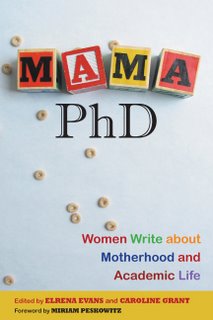 Hello again, Girl w/Penners! I’ve been sequestering myself this fall as I finish work on a book of my own but I am very glad to jump back into getting the word out about some of the amazing new books that explore the realities of contemporary women’s lives.
Hello again, Girl w/Penners! I’ve been sequestering myself this fall as I finish work on a book of my own but I am very glad to jump back into getting the word out about some of the amazing new books that explore the realities of contemporary women’s lives.
You know that feeling when you sense a new book, acquaintance, or connection is going to be deeply important to you and you’ve stumbled onto something that will be profoundly affecting? That’s how I felt when I first saw the title Mama, PhD— putting together two terms that aren’t usually seen in conjunction – which is, of course, the whole point of this collection. Its rich collection of essays explores how these two topics mesh (and more often crash and contort). By the time I finished reading, my book had as many underlines, post-its and corner-turned-pages as any of my graduate school texts and I daresay had far greater an impact.
The contributors in this book, edited by Caroline Grant and Elrena Evans, break the seal of silence that suppresses the intense difficulties and institutionalized prejudice that academics who want to be more than just a “head on a stick” – but rather a whole person, including a maternal body – experience. And the pressures that result for women as their likely prime childbearing years meet squarely with the ticking of the tenure clock is intense. The book’s contributors, from a range of academic fields and even generations, outline in often poignant and sometimes excruciating detail how they are forced to choose between career and family, or find creative, often exhausting, and most likely just plain lucky ways to tie the two together.

 Yesterday, Paul Raeburn, who is in my author’s group, posted about some studies that might have naturally included fathers but which examined only mothers in
Yesterday, Paul Raeburn, who is in my author’s group, posted about some studies that might have naturally included fathers but which examined only mothers in I tell ya, a girl trying to scramble her way to motherhood can sure get whiplash these days. There’s some great reading out there, and some frustrating reading.  My response to Alex Kuczynski’s cover story in this weekend’s NYTimes magazine (
I tell ya, a girl trying to scramble her way to motherhood can sure get whiplash these days. There’s some great reading out there, and some frustrating reading.  My response to Alex Kuczynski’s cover story in this weekend’s NYTimes magazine ( These three researchy news items just in, courtesy
These three researchy news items just in, courtesy 



